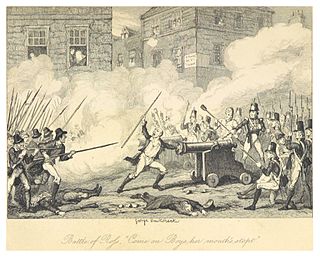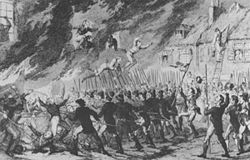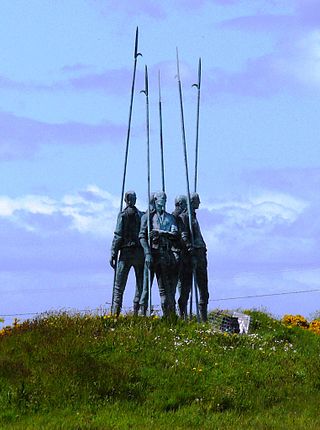
The Irish Rebellion of 1798 was a popular insurrection against the British Crown in what was then the separate, but subordinate, Kingdom of Ireland. The main organising force was the Society of United Irishmen. First formed in Belfast by Presbyterians opposed to the landed Anglican establishment, the Society, despairing of reform, sought to secure a republic through a revolutionary union with the country's Catholic majority. The grievances of a rack-rented tenantry drove recruitment.

The Battle of New Ross was a military engagement which took place in New Ross, County Wexford during the Irish Rebellion of 1798. It was fought between the Society of United Irishmen rebels and government forces garrisoning the town. The attack on the town of New Ross on the River Barrow, was an attempt by the recently victorious rebels to break out of county Wexford across the river Barrow and to spread the rebellion into county Kilkenny and the outlying province of Munster.

The Battle of Prosperous was a military engagement between British Crown forces and United Irishmen rebels during the Irish Rebellion of 1798 in the town of Prosperous, County Kildare. Prosperous was founded by Sir Robert Brooke in 1780 as a village for processing cotton produced in the Americas. When a rebellion spearheaded by the United Irishmen broke out against British rule in Ireland, rebel forces led by John Esmonde made plans to capture Prosperous. Esmonde had 200 rebels under his command, while Prosperous was garrisoned by elements of the Royal Cork City Militia under the command of Captain Richard Swayne reinforced by detachments of a Welsh mounted fencible regiment, the Ancient British Regiment of Fencible Cavalry Dragoons, numbering 150 men in all.

The Battle of Three Rocks was a United Irish victory during the Wexford Rebellion, a part of the 1798 rebellion, against a British artillery column marching to reinforce Wexford town against anticipated rebel attack.

The Battle of Tara Hill was fought on the evening of 26 May 1798 between British forces and Irish rebels involved in the Irish Rebellion of 1798, resulting in a heavy defeat for the rebels and the end of the rebellion in County Meath.
The Battle of Ballyellis on 30 June 1798 was a clash during the Irish Rebellion of 1798, between a surviving column of the dispersed Wexford rebel army and pursuing British forces which resulted in a victory for the rebels.

The second Battle of Arklow took place during the Irish Rebellion of 1798 on 9 June when a force of United Irishmen from Wexford, estimated at 10,000 strong, launched an assault into County Wicklow, on the British-held town of Arklow, in an attempt to spread the rebellion into Wicklow and to threaten the capital of Dublin.
Anthony Perry, known as the "screeching general" was one of the most important leaders of the United Irish Wexford rebels during the 1798 rebellion.
The Battle of Tubberneering was a battle of the Wexford Rebellion fought on 4 June 1798 between Crown forces and United Irish insurgents, at Tubberneering south of Gorey in the north of County Wexford. The rebels ambushed and routed the British.
The battle of Ovidstown was a military engagement between British Crown forces and United Irishmen rebels during the Irish Rebellion of 1798 near the town of Kilcock, County Kildare. Despite the initial failures experienced by the United Irishmen in County Kildare during the first months of the rebellion, the consolidation of government forces in the town of Naas and the priority given by the Dublin Castle administration to suppress the Wexford Rebellion in County Wexford meant that much of the county remained in rebel hands since the outbreak of the rebellion. Towns such as Prosperous and Clane were in rebel hands, while towns such as Maynooth, Kilcock and Kildare had been attacked and briefly occupied by the rebels. By 19 June, however, neighbouring County Meath had been judged sufficiently pacified to allow for government forces to be dispatched from that county into Kildare to recapture rebel-held territory.
The Dunlavin Green executions was summary execution of 36 suspected United Irishmen rebels in County Wicklow, Ireland by the Irish Yeomanry shortly after the outbreak of the rebellion of 1798. There are several accounts of the events, recorded at differing times and differing in detail.

John Murphy was an Irish Roman Catholic priest of the Roman Catholic Diocese of Ferns, who is mainly remembered for his central role in the Irish Rebellion of 1798 in County Wexford, which is sometimes known as the Wexford Rebellion. He led the rebels to one of their initial victories over a government militia at Oulart Hill, and in the following weeks became one of the rebellion's main leaders.
Events from the year 1798 in Ireland.
The Battle of the Harrow took place on 26 May 1798 and was the first clash of the Irish Rebellion of 1798 in County Wexford. It was fought between government forces and United Irishmen insurgents under the leadership of a local priest, John Murphy who had mobilized following reports of atrocities by the yeomanry during the rebellion led by the United Irishmen revolutionary organisation.
Beauchamp Bagenal Harvey was a barrister and a commander of the United Irishmen in the Battle of New Ross during the 1798 Rebellion.

The Wexford Rebellion refers to the events of the Irish Rebellion of 1798 in County Wexford. From 27 May until 21 June 1798, Society of United Irishmen rebels revolted against British rule in the county, engaging in multiple confrontations with Crown forces. The most successful and destructive rising in all the counties of Ireland, United Irishmen rebels experienced a number of early successes in the county despite being seen as a relatively loyal county by the Dublin Castle administration due to a series of military victories. However, the tide soon turned against the United Irishmen in Wexford as Crown forces poured into the region, engaging in a brutal counterinsurgency which indiscriminately targeted suspected rebels and eventually suppressed all rebel activities in the county.

The battle of Ballynahinch was a military engagement of the Irish Rebellion of 1798 between a force of roughly 4,000 United Irishmen rebels led by Henry Munro and approximately 2,000 government troops under the command of George Nugent. After rebel forces had occupied Newtownards on 9 June, they gathered the next day in the surrounding countryside and elected Munro as their leader, who occupied Ballyhinch on 11 June. Nugent led a column of government troops in 12 June which recaptured the town and bombarded rebel positions. On the next day, the rebels attacked Ballyhinch, but were driven back and defeated.

The Battle of Enniscorthy was a land battle fought during the Irish Rebellion of 1798, on 28 May 1798, when an overwhelming force of rebels assailed the town of Enniscorthy, County Wexford, which was defended only by a 300-strong garrison supported by loyalist civilians. On the previous day at nearby Oulart, several thousand rebels led by Fr John Murphy had massacred a detachment of the North Cork militia, amounting to 110 officers and men.

The Battle of the Big Cross was a military engagement of the Irish Rebellion of 1798 between a force of United Irishmen rebels and a column of government troops. It was fought on 19 June 1798 on a spot on the Shannonvale-Ballinascarty road known locally as the "Big Cross", approximately four miles east of Clonakilty in West Cork. It was the only battle fought in the rebellion in County Cork.

The Battle of Clonard occurred on 11 July 1798 near Leinster Bridge in the town of Clonard, County Meath, during the Irish Rising of that year. A combined force of between 2,000 and 4,000 United Irishmen engaged a force of 27 British loyalist militia troops led by Lieutenant Thomas Tyrrell over 6 hours in an attempt to cross the River Boyne. The defenders held the fortified house until they were reinforced by a Sergeant and 11 men of the Northumberland Fencibles and 15 men of the Kinnegad Cavalry under the command and including Lt Edward Haughton when the rebels were routed and retreated to Carbury. The attack on Clonard was a disastrous failure and a severe blow to the surviving rebels. Many of the Kildare rebels returned to their homes while many of the Meath men were dissuaded from joining the rebellion by the defeat and due to much of their existing stocks of ammunition being wasted in the battle.












